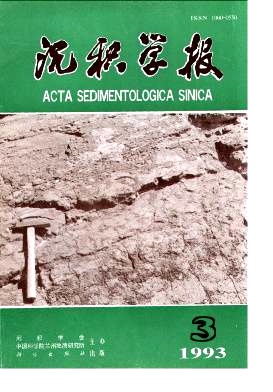Microspherulitic and Clastic Mineral in the Clay Rock Near the Permian-Triassic Interface ofZhongliangshan Mountain, Chongqing
- Received Date: 1991-08-06
- Publish Date: 1993-09-10
Abstract: Several clay rock beds ware found near the Permian-Triassic interface of Southern China, and there is a large mass of extinction. There are two opinions on the cause of the extinction, i. e., outer-space crash event and volcanism of the earth. The author, after analyzed the non - clay components the mentioned clay beds in Zhongliangshan of Chongqing, found some microspherulitic and clastic minerals that featured by the following characters. 1. Microspherulitic material, with the diameters of 30-150μm and composed by (1) ferruginous, (2) siliceous and (3) lithical components. Division 1 is very round (nearly standard globular) with smooth surface or decorated by modular bulges. The most outstanding feature is their graphic texture on the surface, which made of dendritic, small bulges, holes of eruption and fusion crust. EDX analysis shows that the elemental components are Fe (avrage in 85. 0%), Si (12. 3% in average), some Al, Ni, Cr, Mg and Mn, distribute inhomogenously. The highest concentration of Fe is found in the eruption holes and on the crust around the holes, Al and Si concentrated on the surface of the spherulitic balls, especially on the noduler bulges. concentrated on the noduler bulges, while Ni, Cr and Mn only found inside the eruption holes and Mg only on the surface of the spherule. No obvious diffence between the dendritic bulges and the depressed parts in the distribution of Fe and Si. Division 2 and 3. siliceous and lithical microspherulitic matters, are global or pear - like, mostly with a simple smooth surface. and a few have eruption holes. EDX analysis revealed that the component of silicer-ous one is Si (75. 2%). Al (15. 0%), some Ti and Fe, and for lithical ones, are mainly lithophile elements, i.e., Si, Al, K, Fe, Zn, Ti and Mg. 2. Clastic Minerals Include zircon, magnetite, hexagonxl dipyramid quartz and mtile. Most of them are excellent euhedral crystals with few trace of abrasion, and in the size of 30-300μm. The crystal form of quartz is frequently hexagonal dipyramid. Some of zircon, so called "double prisms and double pyramids", belongs to S22 type of Pupin (1980), representing the forming temperature appproxi-mately 850℃. The crystal form of magnetite mainly is rhombic dodecahedron. The types and crystal forms of clastic minerals have the characters reflecting that the origin of clay rock near the Permian -Triassic boundary could be related to volcanic activities. The siliceous and lithical micro-spherules also could be pyroclast because of their high content of Ti Their surface with melting structure of high temperature, such as eruption holes,also resulted from volcaic eruption. The forruginous microspherule with graphic textrue also have fusion crust formed at high temperature process like that seen in siliceous and lithical microspherulitic matter but no Ti has been found in them. In the core part of ferruginous microspherulitic matter there is relatively high content of Ni but no Si has been found. In contrast, Si and Al are mainly distrbuted in the part near surface of the ferruginous microspherulitic matter it is our proposal that this dind of microspherulitic matter could be of extraterrestrial origin, i.e., cosmic dust. It follows form our study that both extraterrestrial dashevent and terrestrial volcanicity probably be happened at teh end of the permian in southern chinaand both could be related to the mass extinction.
| Citation: | Huang Sijing. Microspherulitic and Clastic Mineral in the Clay Rock Near the Permian-Triassic Interface ofZhongliangshan Mountain, Chongqing[J]. Acta Sedimentologica Sinica, 1993, 11(3): 105-113. |






 DownLoad:
DownLoad: